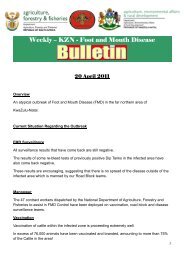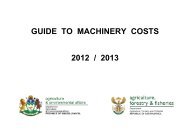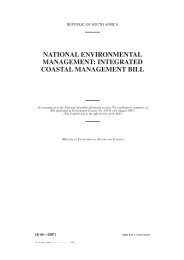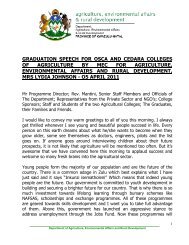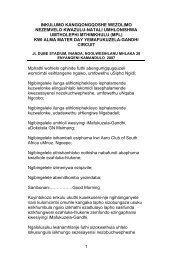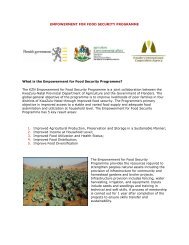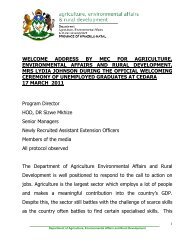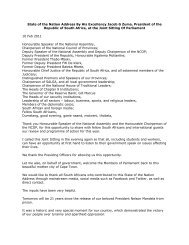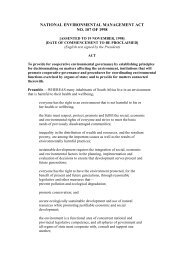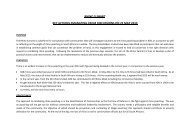Socio-Economic Report - Department of Agriculture and ...
Socio-Economic Report - Department of Agriculture and ...
Socio-Economic Report - Department of Agriculture and ...
You also want an ePaper? Increase the reach of your titles
YUMPU automatically turns print PDFs into web optimized ePapers that Google loves.
UDM ENVIRONMENTAL MANAGEMENT FRAMEWORK<br />
Gedleza Clinic Madonela Cinic Mhlekazi Clinic Ophansi Clinic.<br />
Jozini Clinic Makhathini Clinic Mkuze Clinic Bethesda Gateway Clinic<br />
HEALTH STATUS<br />
The UDM SDF mentions that minimal/lack <strong>of</strong> water <strong>and</strong> electricity limits the level <strong>and</strong><br />
quality <strong>of</strong> health care in the area. Additional constraints affecting quality healthcare is<br />
the shortage <strong>of</strong> doctors in the region (Isikhungusethu Environmental Services (Pty)<br />
Ltd, 2008).<br />
HIV/AIDS is estimated to be the highest in uMkhanyakude from all KwaZulu-Natal<br />
districts. No exact figures could be provided on a local or district level, which is<br />
already a cause <strong>of</strong> concern. Associated with HIV/AIDs is the high number <strong>of</strong><br />
tuberculosis patients. The high prevalence rate not only decreases life expectancy, it<br />
has significant impacts on the productivity <strong>of</strong> the population. The impact <strong>of</strong> HIV/AIDS<br />
in UDM is aggravated by the high level <strong>of</strong> poverty in the area, making it difficult for<br />
people to escape the poverty trap (Isikhungusethu Environmental Services (Pty) Ltd,<br />
2008).<br />
According to Quantec Research Data for 2007, there are 93 968 persons living with<br />
HIV. Also, the number <strong>of</strong> AIDs deaths in uMkhanyakude were 7 244 persons <strong>and</strong> all<br />
other deaths amounted to 5 124 (Quantec Research (Pty) Ltd, 2012). This reflects<br />
the importance <strong>of</strong> addressing the HIV/AIDS problem.<br />
Malnutrition, especially among children is reported to be high in uMkhanyakude DM.<br />
Malnourished children are more susceptible to infectious disease <strong>and</strong> low education<br />
leading to reduce life expectancy <strong>and</strong> low levels <strong>of</strong> productivity. Where malnutrition<br />
exist on such a scale, it is clear that there is a need for intervention, either public or<br />
private, to stimulate sustainable economic growth that will allow the community to<br />
uplift itself to a high st<strong>and</strong>ard <strong>of</strong> living, where basic needs are met.<br />
A report on uMkhanyakude DM by the Business Trust <strong>and</strong> <strong>Department</strong> <strong>of</strong> Provincial<br />
<strong>and</strong> Local Government (2007) mention the presence <strong>of</strong> environment health issues in<br />
the district. The lack <strong>of</strong> waste management <strong>and</strong> cemetery /crematorium facilities<br />
contribute to the existence <strong>of</strong> water-borne diseases (e.g. cholera) in the area<br />
(Business Trust, 2007).<br />
The figure below is a map taken from the Provincial <strong>Economic</strong> Development Strategy<br />
for KwaZulu-Natal Province. The left map shows the incidence <strong>of</strong> children under five<br />
years not gaining weight <strong>and</strong> on the right is a map <strong>of</strong> malnutrition incidence.<br />
<strong>Socio</strong>-<strong>Economic</strong> Assessment Page 30



